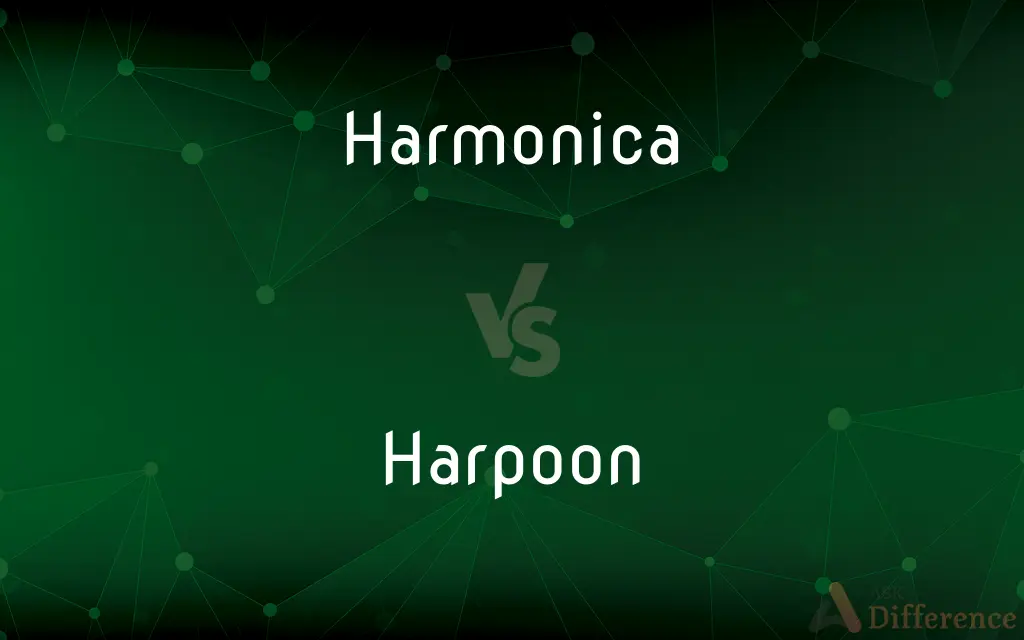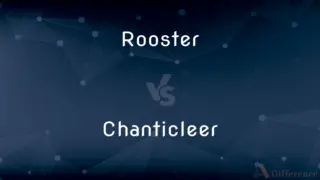Harmonica vs. Harpoon — What's the Difference?
By Fiza Rafique & Maham Liaqat — Updated on March 29, 2024
The harmonica produces melody through reeds and breath control, whereas a harpoon is a spear-like tool for hunting aquatic life.

Difference Between Harmonica and Harpoon
Table of Contents
ADVERTISEMENT
Key Differences
The harmonica, often used in music genres like blues, folk, and rock, relies on air blown or drawn through reeds to create sound. This instrument is compact, making it portable and versatile in various musical settings. On the other hand, a harpoon is designed for hunting, specifically aquatic animals like fish and whales. It has a sharp, pointed head attached to a long shaft, often connected to a rope, allowing the hunter to capture and retrieve the target.
While the harmonica is a tool for artistic expression, capable of producing a wide range of emotions and tones through its musical notes, the harpoon is a tool of survival and industry, used historically and currently in fishing and whaling to secure food and resources. The former requires skill in breath control and rhythm, fostering a unique connection between the musician and their instrument, whereas the latter requires physical strength, precision, and often teamwork to be used effectively in its intended environment.
Harmonicas come in various types, such as diatonic, chromatic, and tremolo, each offering different musical scales and sound textures, enabling musicians to select one that best suits their style and the music genre they are performing. In contrast, harpoons vary in design based on their intended use, including hand-held versions for traditional fishing and mechanically powered versions for large-scale whaling operations. These differences reflect the harmonica's role in cultural expression versus the harpoon's function in economic activity and subsistence.
The harmonica’s history is rich with stories of travel, migration, and cultural exchange, symbolizing freedom and creativity. It has been a companion of soldiers, travelers, and musicians, easily carried in a pocket and played around campfires and in parlors. Conversely, the harpoon carries a history of maritime adventure, economic necessity, and often controversial practices, especially in modern contexts concerning conservation and ethical debates around whaling.
The playing technique for the harmonica involves nuances of lip position, breath control, and hand movement to alter the instrument's sound, offering a personal touch to each performance. Conversely, using a harpoon effectively requires knowledge of the target's behavior, skill in throwing or launching the tool, and the ability to manage the attached line once the target is struck, highlighting a direct engagement with the natural world.
ADVERTISEMENT
Comparison Chart
Primary Use
Musical instrument
Hunting tool
Operation
Blown or drawn air through reeds
Thrown or launched at aquatic animals
Variety
Diatonic, chromatic, tremolo
Hand-held, mechanically powered
Skill Required
Breath control, rhythm
Physical strength, precision
Cultural Significance
Artistic expression, freedom
Maritime adventure, economic necessity
Compare with Definitions
Harmonica
Easily carried and played anywhere, making it a favorite among travelers.
She packed her harmonica for the trip, knowing it would be her companion by the campfire.
Harpoon
Includes hand-held and mechanically powered types.
Modern whalers use a mechanically powered harpoon for efficiency.
Harmonica
A small musical instrument played by blowing air through it, producing sound via metal reeds.
The blues musician captivated the audience with his harmonica's soulful tunes.
Harpoon
Requires knowledge of aquatic animal behavior and skillful handling.
Using a harpoon effectively demands great precision and understanding of the sea.
Harmonica
Symbolizes freedom and creativity, with a rich history in music.
The harmonica has been a cultural icon, representing the spirit of the American blues.
Harpoon
Associated with debates on conservation and ethics.
The use of harpoons in whaling has sparked international debates on animal rights.
Harmonica
Involves nuanced breath control and lip movement.
Mastering the harmonica required him to learn precise breath control techniques.
Harpoon
A long spear-like instrument used in fishing and whaling to catch large aquatic animals.
The fisherman skillfully threw the harpoon to catch the fleeing marlin.
Harmonica
Used across various genres, from folk to rock, showcasing its adaptability.
The band's harmonica player brought a unique sound to their rock anthem.
Harpoon
Primarily used for securing food and resources from the sea.
Historically, the harpoon was essential for survival in coastal communities.
Harmonica
The harmonica, also known as a French harp or mouth organ, is a free reed wind instrument used worldwide in many musical genres, notably in blues, American folk music, classical music, jazz, country, and rock. The many types of harmonica include diatonic, chromatic, tremolo, octave, orchestral, and bass versions.
Harpoon
A harpoon is a long spear-like instrument and tool used in fishing, whaling, sealing, and other marine hunting to catch large fish or marine mammals such as whales. It accomplishes this task by impaling the target animal and securing it with barb or toggling claws, allowing the fishermen to use a rope or chain attached to the projectile to catch the animal.
Harmonica
A small rectangular instrument consisting of a row of free reeds set back in air holes, played by exhaling or inhaling. Also called mouth harp, mouth organ; also called regionally French harp.
Harpoon
A barbed spear attached to a rope and thrown or fired from a gun, used especially in whaling.
Harmonica
A glass harmonica.
Harpoon
To strike, kill, or capture with or as if with a harpoon.
Harmonica
An instrument consisting of tuned strips of metal or glass fixed to a frame and struck with a hammer.
Harpoon
A spearlike weapon with a barbed head used in hunting whales and large fish.
Harmonica
A musical wind instrument with a series of holes for the player to blow into, each hole producing a different note
Harpoon
(slang) A harmonica.
Harmonica
A musical instrument, consisting of a series of hemispherical glasses which, by touching the edges with the dampened finger, give forth the tones.
Harpoon
(transitive) To shoot something with a harpoon.
Harmonica
A toy instrument of strips of glass or metal hung on two tapes, and struck with hammers.
Harpoon
A spear or javelin used to strike and kill large fish, as whales; a harping iron. It consists of a long shank, with a broad, flat, triangular head, sharpened at both edges, and is thrown by hand, or discharged from a gun.
Harmonica
A musical instrument, consisting of a series of hemispherical glasses which, by touching the edges with the dampened finger, give forth the tones; it is now called the glass harmonica, to distinguish it from the common harmonica, formerly called the harmonicon.
Harpoon
To strike, catch, or kill with a harpoon.
Harmonica
A toy instrument of strips of glass or metal hung on two tapes, and struck with hammers.
Harpoon
A spear with a shaft and barbed point for throwing; used for catching large fish or whales; a strong line is attached to it
Harmonica
A small wind musical instrument shaped like a flat bar with holes along the thin edges, held in the hand and producing notes from multiple vibrating reeds arranged inside along its length; it was formerly called the harmonicon. See harmonicon.
Harpoon
Spear with a harpoon;
Harpoon whales
Harmonica
A small rectangular free-reed instrument having a row of free reeds set back in air holes and played by blowing into the desired hole
Common Curiosities
Can harmonicas play different types of music?
Yes, harmonicas are versatile and used in genres like blues, folk, and rock.
Are there different types of harmonicas?
Yes, including diatonic, chromatic, and tremolo, each offering unique sounds.
What is a harmonica?
A musical instrument that produces sound when air is blown or drawn through reeds.
What skills are needed to use a harpoon?
Strength, precision, and knowledge of the target's behavior are crucial.
How is a harpoon used?
It's used to hunt aquatic animals by being thrown or launched, then retrieved with attached line.
How has the harmonica impacted culture?
It symbolizes freedom and creativity, with a rich history in music.
What are the environmental concerns with harpooning?
Overfishing and endangering species, leading to ecosystem imbalances.
Why is the harpoon controversial?
Due to ethical concerns around whaling and its impact on marine populations.
What is the significance of the harmonica in music?
It adds unique sound textures and emotional depth to compositions.
What makes a harpoon effective?
Its design for penetration and retrieval of large aquatic animals.
Are harpoons used today?
Yes, in certain fishing and whaling practices, though increasingly regulated.
How do harpoons vary?
They range from traditional hand-held spears to modern mechanically powered versions.
Is the harmonica easy to learn?
While accessible, mastering its nuances requires practice and skill.
Can anyone play the harmonica?
Yes, its simplicity and portability make it accessible to many.
How does one choose a harmonica?
Based on the music genre, desired sound, and player's skill level.
Share Your Discovery

Previous Comparison
Rooster vs. Chanticleer
Next Comparison
Marketspace vs. MarketplaceAuthor Spotlight
Written by
Fiza RafiqueFiza Rafique is a skilled content writer at AskDifference.com, where she meticulously refines and enhances written pieces. Drawing from her vast editorial expertise, Fiza ensures clarity, accuracy, and precision in every article. Passionate about language, she continually seeks to elevate the quality of content for readers worldwide.
Co-written by
Maham Liaqat













































